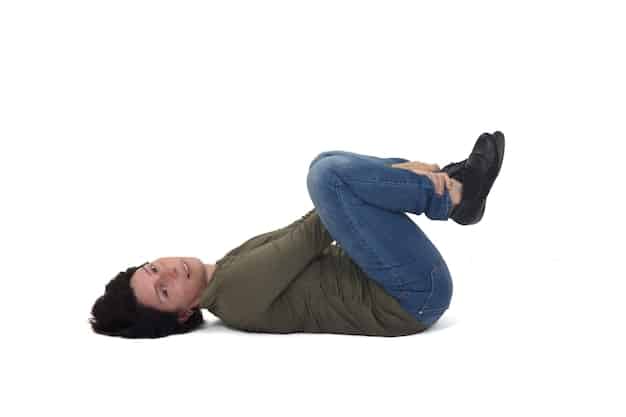The Science of Breathing: Reduce Stress in 5 Minutes

Diaphragmatic breathing, a scientifically-backed technique, can significantly reduce stress in just five minutes by activating the parasympathetic nervous system, promoting relaxation and lowering physiological stress markers.
In today’s fast-paced world, stress has become an unwelcome companion. But what if you could significantly alleviate that stress with just five minutes of focused breathing? The **science of breathing: how 5 minutes of diaphragmatic breathing can instantly reduce stress** reveals a simple yet powerful technique to restore balance and calm.
The Science Behind Diaphragmatic Breathing
Diaphragmatic breathing, also known as belly breathing, is a technique that encourages full, deep breaths, utilizing the diaphragm muscle. Unlike shallow chest breathing, this method promotes relaxation and reduces stress by engaging the body’s natural relaxation response.
This mindful breathing technique isn’t just some new-age fad; it’s rooted in solid physiological principles.
Activating the Relaxation Response
Deep, diaphragmatic breaths stimulate the vagus nerve, a key component of the parasympathetic nervous system. This system is responsible for the “rest and digest” response, counteracting the fight-or-flight response triggered by stress.
Physiological Benefits
When you engage in diaphragmatic breathing, several positive physiological changes occur, contributing to stress reduction and overall well-being.
- Lowered heart rate: Deep breaths slow your heart rate, promoting a sense of calm.
- Reduced blood pressure: Diaphragmatic breathing helps to regulate blood pressure, easing tension in the cardiovascular system.
- Decreased levels of cortisol: This breathing technique can reduce the production of cortisol, the stress hormone, leading to a calmer state of mind.
By understanding the science behind it, you can appreciate the powerful impact of diaphragmatic breathing on your body and mind.
How Diaphragmatic Breathing Works
To effectively utilize diaphragmatic breathing, it’s important to understand the mechanics involved. This technique focuses on using the diaphragm, a large muscle located at the base of your lungs, to facilitate deeper and more efficient breaths.
Getting the technique right is crucial for experiencing its full benefits.
The Correct Posture
Begin by lying on your back with your knees bent or sitting comfortably in a chair with your feet flat on the floor. This ensures proper alignment and allows your diaphragm to move freely.
Hand Placement
Place one hand on your chest and the other on your abdomen, just below your ribs. This allows you to feel the movement of your diaphragm as you breathe.

The Breathing Process
Inhale slowly and deeply through your nose, allowing your abdomen to rise while keeping your chest relatively still. Exhale slowly through your mouth, drawing your abdomen in. Focus on making each breath smooth and controlled.
With practice, you’ll notice that your belly rises and falls more than your chest, indicating that you’re properly engaging your diaphragm. This technique ensures you’re taking full, effective breaths that maximize relaxation.
5-Minute Diaphragmatic Breathing Exercise
Integrating diaphragmatic breathing into your daily routine is simple and can be extremely effective in managing stress. Here’s a practical five-minute exercise you can follow.
Setting aside just five minutes can make a significant difference in your stress levels.
Step-by-Step Guide
Find a quiet and comfortable space where you won’t be disturbed. Close your eyes and focus on your breath. Inhale slowly through your nose for a count of four, allowing your abdomen to rise. Hold your breath for a count of one, and then exhale slowly through your mouth for a count of six, drawing your abdomen in. Repeat this cycle for five minutes.
Consistency is key, so try to practice this exercise at the same time each day.
Tips for Beginners
If you find it difficult to coordinate the breathing pattern, start with shorter breaths and gradually increase the duration as you become more comfortable. It’s also helpful to visualize a calming scene or focus on a positive affirmation during the exercise.
- Start Slow: Don’t rush the process; focus on smooth, controlled breaths.
- Be Patient: It may take time to feel the full effects of diaphragmatic breathing.
- Stay Consistent: Regular practice will enhance your ability to relax quickly.
Remember, the goal is to create a sense of calm and relaxation, so don’t get discouraged if you don’t feel the effects immediately. With practice, you’ll find diaphragmatic breathing to be a valuable tool in your stress management toolkit.
Benefits of Regular Diaphragmatic Breathing
The benefits of regularly practicing diaphragmatic breathing extend far beyond immediate stress relief. Consistent use of this technique can lead to significant improvements in your overall physical and mental well-being.
It’s a simple yet powerful tool for long-term wellness.
Reduced Anxiety and Depression
Diaphragmatic breathing has been shown to reduce symptoms of anxiety and depression by promoting a sense of calm and reducing negative thought patterns. When you consciously control your breathing, you’re better able to manage your emotional state.
Improved Sleep Quality
By calming the nervous system, diaphragmatic breathing can improve sleep quality. Incorporating this technique into your bedtime routine can help you fall asleep faster and enjoy more restful sleep.

Enhanced Focus and Concentration
Deep breathing increases oxygen flow to the brain, which can enhance focus and concentration. Practicing diaphragmatic breathing before engaging in tasks that require mental clarity can improve your performance.
- Better Cognitive Function: Increased oxygen supports optimal brain function.
- Improved Emotional Regulation: Helps manage impulsive reactions and emotional outbursts.
- Increased Energy Levels: More efficient breathing can combat fatigue and improve overall energy.
By making diaphragmatic breathing a regular part of your life, you’ll experience a wide range of benefits that contribute to a healthier and more balanced lifestyle. It’s a simple yet effective way to support your overall well-being.
Integrating Breathing into Daily Life
While setting aside five minutes for dedicated diaphragmatic breathing exercises is beneficial, the true power of this technique lies in integrating it into your everyday life. By being mindful of your breath throughout the day, you can manage stress proactively.
Making it a seamless part of your routine ensures constant benefits.
Mindful Moments
Take a few deep breaths whenever you feel stressed or overwhelmed. This could be during a challenging meeting, while stuck in traffic, or anytime you need a moment of calm. Even a few breaths can make a difference.
Breathing Breaks
Schedule short breathing breaks throughout the day, similar to how you would schedule a coffee break. These breaks can help you reset and refocus, preventing stress from building up.
Combining with Other Practices
Pair diaphragmatic breathing with other relaxation techniques, such as meditation, yoga, or progressive muscle relaxation. This can enhance the overall stress-reducing effects.
By weaving diaphragmatic breathing into your daily routine, you create a continuous and supportive practice that helps you manage stress and stay grounded throughout the day. It’s about making breathing an active part of your self-care.
Potential Challenges and Solutions
While diaphragmatic breathing is a simple and effective technique, you may encounter some challenges when first starting out. Understanding these potential obstacles and knowing how to address them can help you stick with the practice and reap its benefits.
Knowing how to overcome obstacles ensures long-term success.
Feeling Lightheaded
Some people may feel lightheaded or dizzy when they first start practicing diaphragmatic breathing. This is usually due to the increased oxygen intake and can be easily resolved by slowing down your breathing pace.
Difficulty Coordinating Breath
It can be challenging to coordinate the breathing pattern at first. If you find it difficult, try practicing in front of a mirror to visualize your abdomen rising and falling. Persistence is key.
Staying Consistent
Maintaining consistency can be tough, especially when life gets busy. To combat this, set realistic goals and incorporate breathing exercises into your daily routine at a time that works best for you.
By anticipating these challenges and having solutions in place, you can ensure that diaphragmatic breathing becomes a sustainable and valuable part of your stress management strategy. Remember, small adjustments and consistent effort lead to significant results.
| Key Point | Brief Description |
|---|---|
| 🧘♀️ Diaphragmatic Breathing | Deep breathing technique using the diaphragm for relaxation. |
| ⏱️ 5-Minute Exercise | A quick way to reduce stress by focusing on controlled breaths. |
| 🧠 Mental Benefits | Reduces anxiety, improves sleep, and enhances focus. |
| 🔄 Daily Integration | Incorporate into daily routines for sustained stress management. |
FAQ
▼
Diaphragmatic breathing, also known as belly breathing, is a technique that involves taking deep, full breaths that engage the diaphragm, a muscle located at the base of the lungs. This contrasts with shallow chest breathing.
▼
Five minutes of diaphragmatic breathing can reduce stress by activating the parasympathetic nervous system, promoting relaxation, and reducing physiological stress markers like heart rate and cortisol levels.
▼
The correct posture involves lying on your back with your knees bent or sitting comfortably in a chair with your feet flat on the floor. Place one hand on your chest and the other on your abdomen to feel the diaphragm’s movement.
▼
For optimal results, practice diaphragmatic breathing daily. You can practice multiple times a day, especially during moments of stress or anxiety. Consistency is key to experiencing its full benefits.
▼
Some people may experience lightheadedness or dizziness initially due to increased oxygen intake. This is usually temporary and can be resolved by slowing down the breathing pace. Consult a healthcare professional if concerns persist.
Conclusion
Incorporating the science of breathing: how 5 minutes of diaphragmatic breathing can instantly reduce stress into your daily routine offers a simple yet profound method for managing stress and enhancing overall well-being. By understanding the science behind it and practicing regularly, you can unlock a powerful tool for calm and balance.





